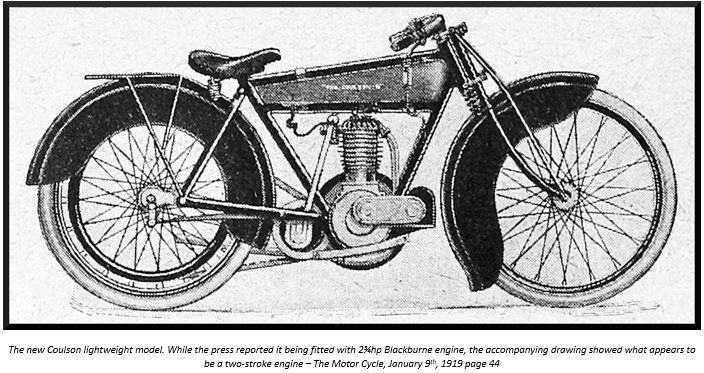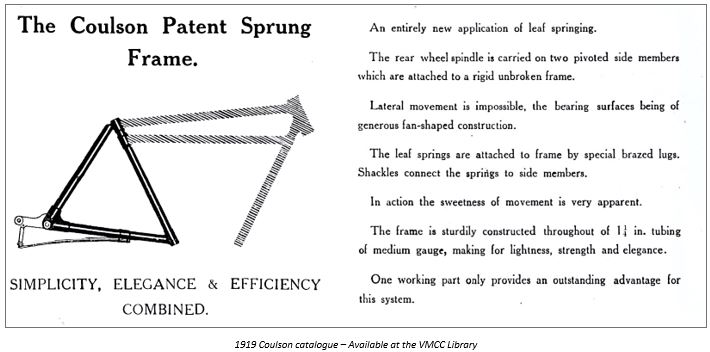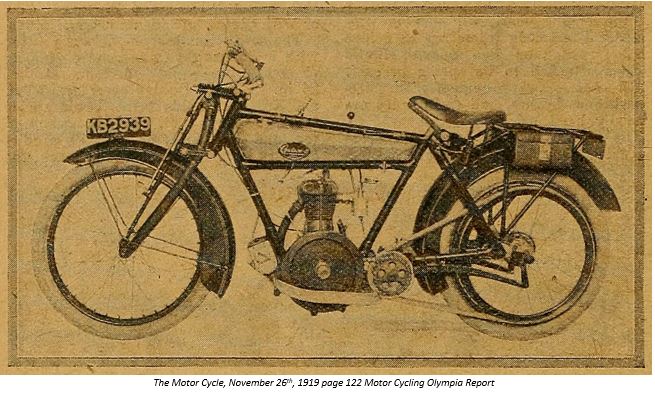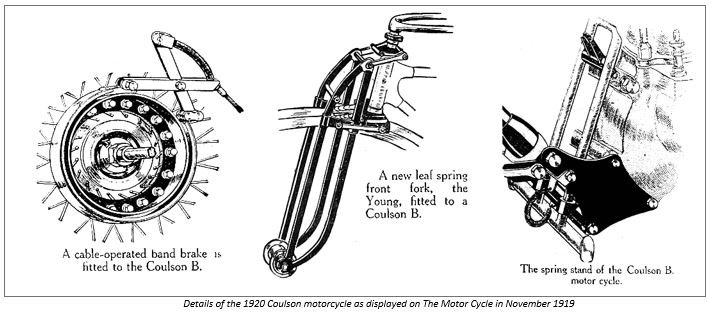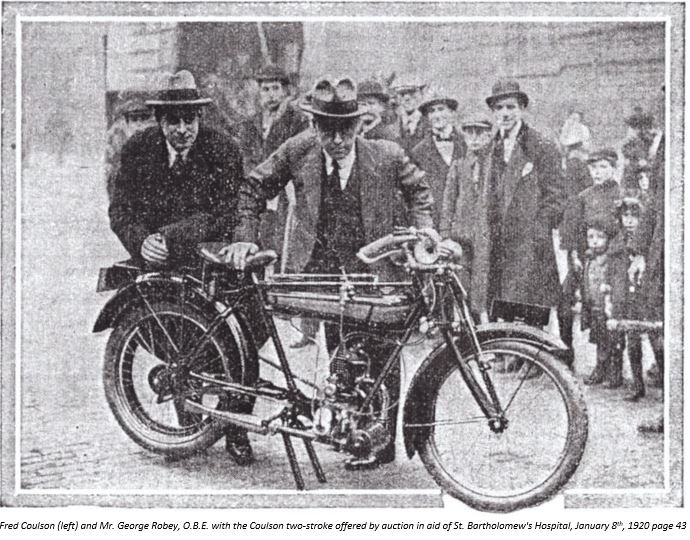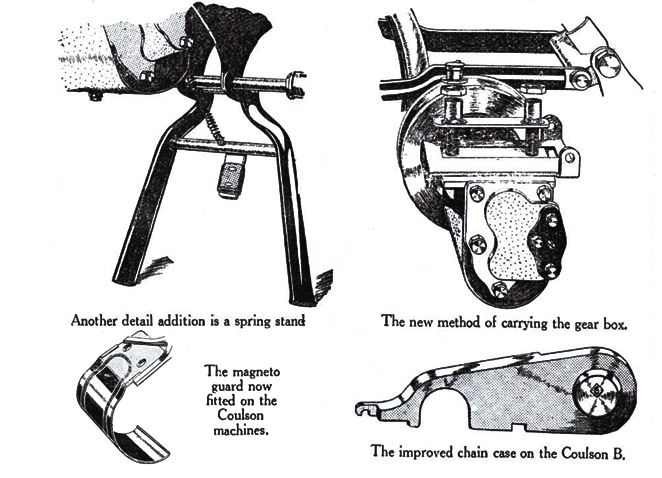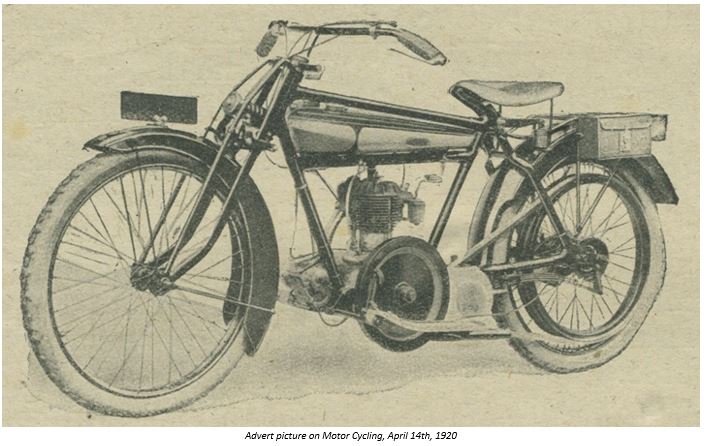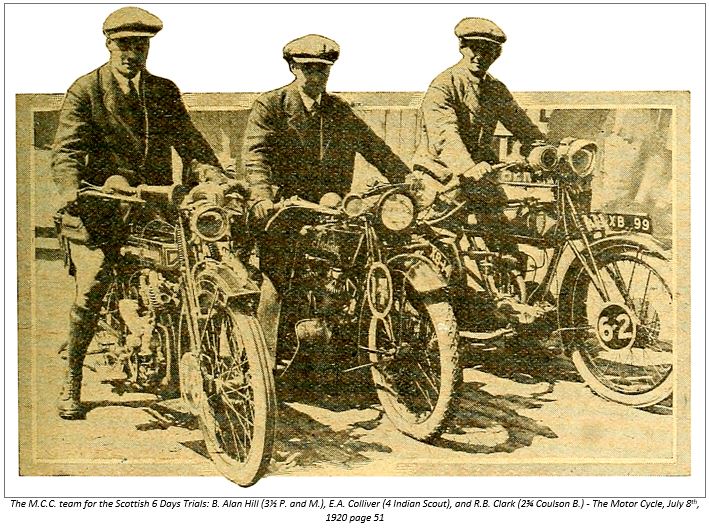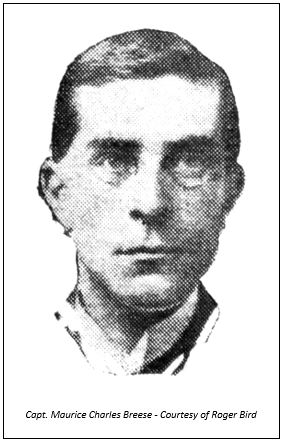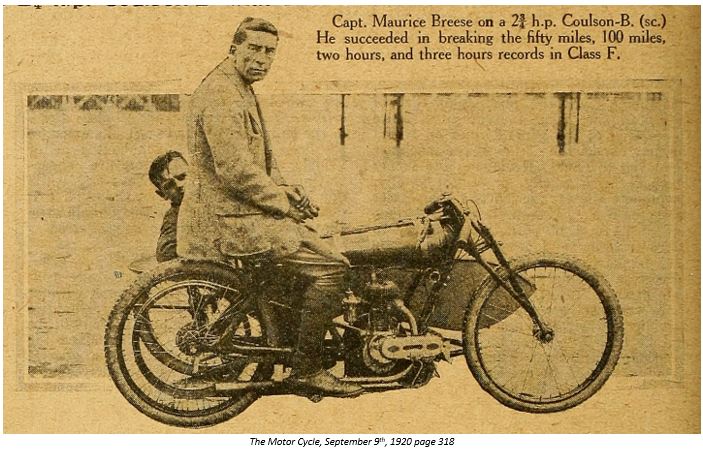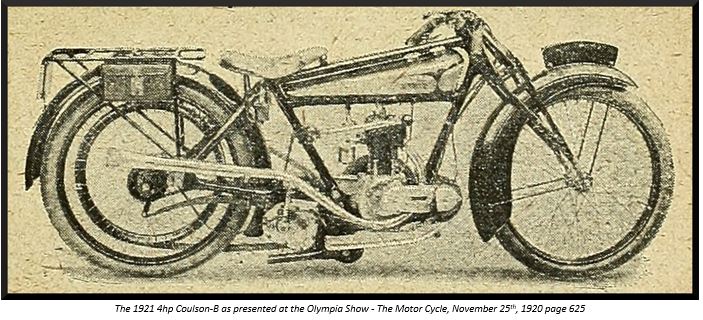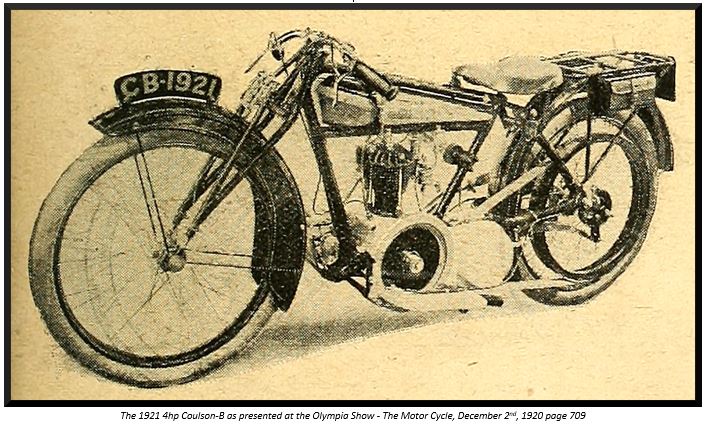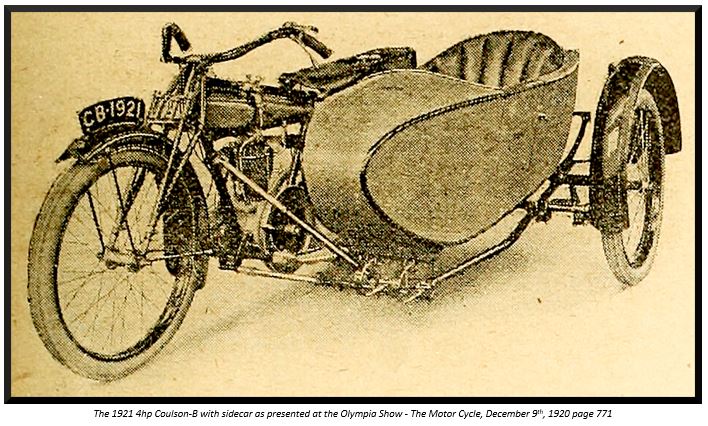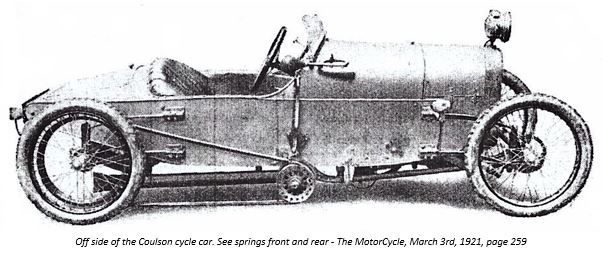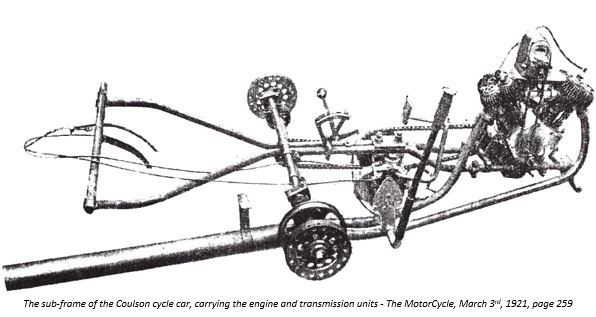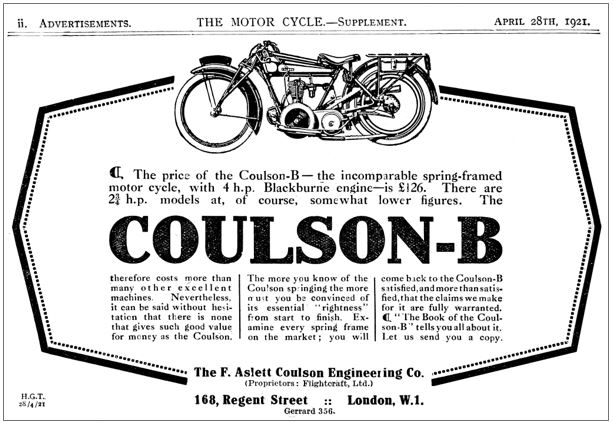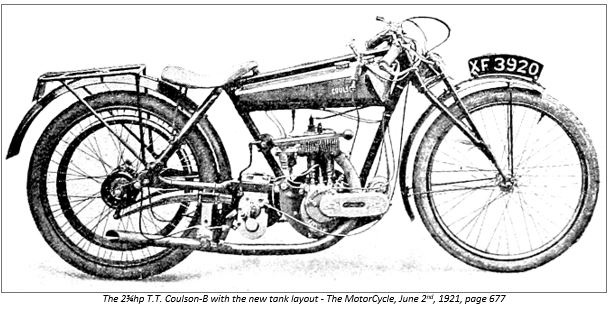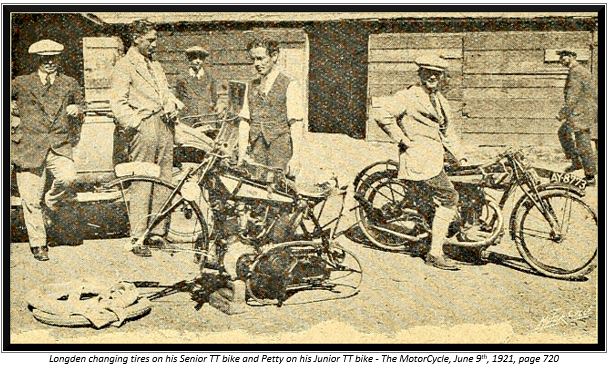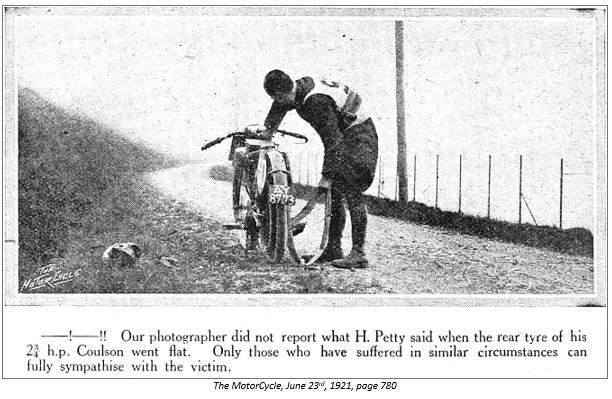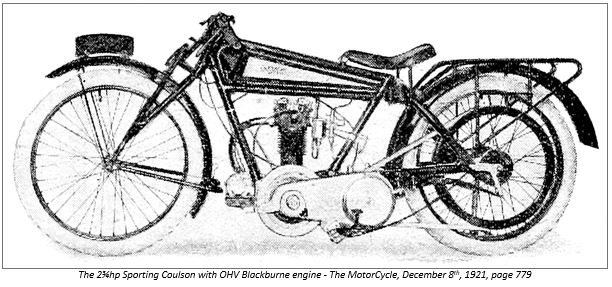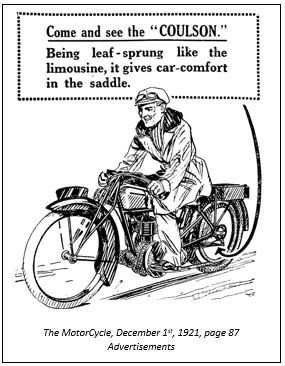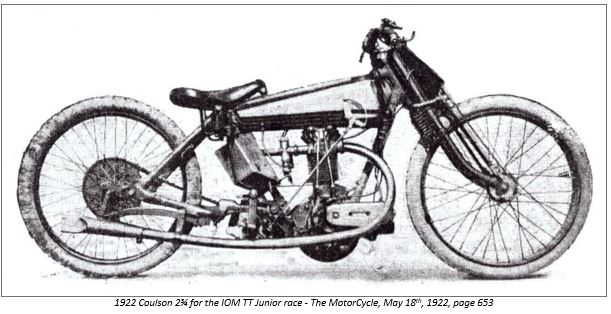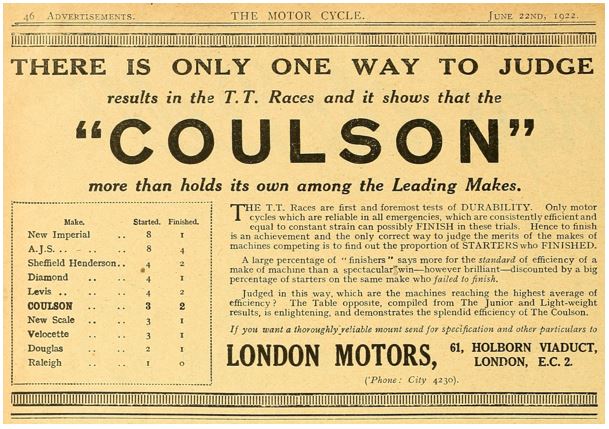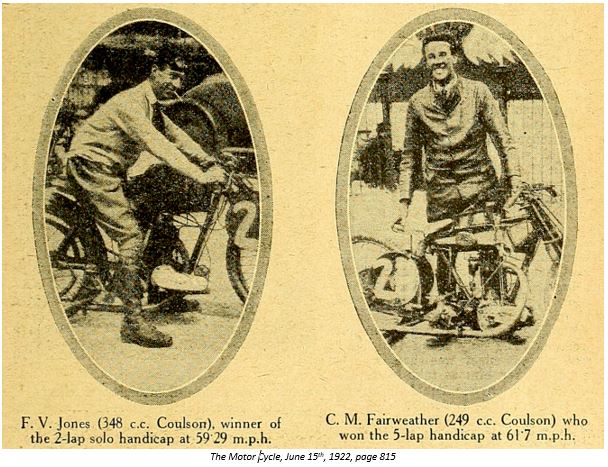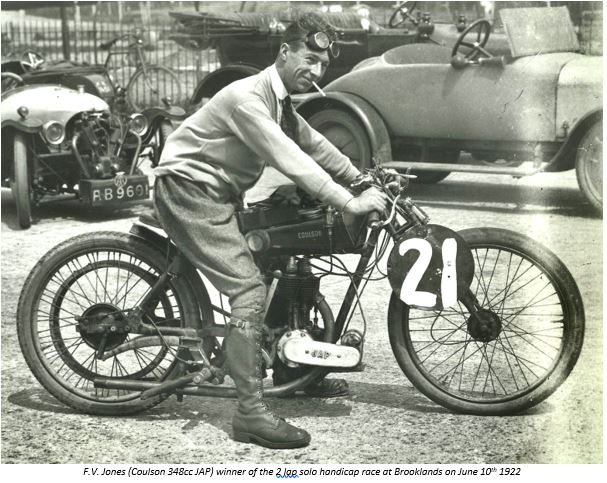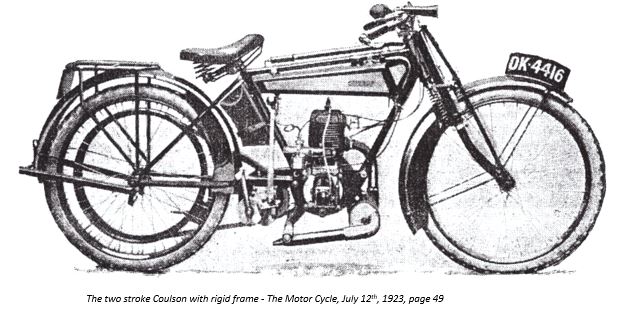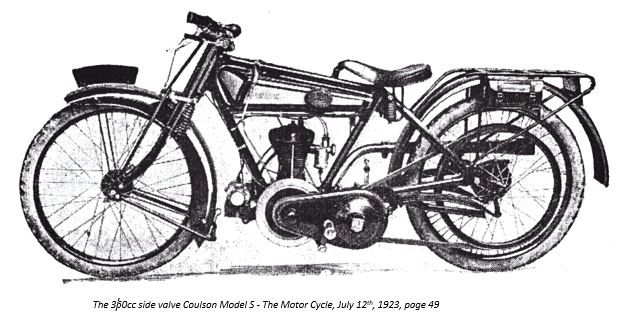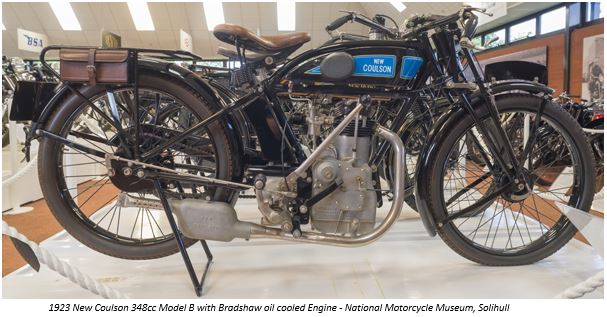COULSON-B
Our thanks to Giovanni Orlando for compiling the following material and giving us permission to publish on the VMCC web site. Giovanni is the VMCC Marque Specialist for Coulson motorcycles.
"The Coulson-B is built to fight the road - not the rider!"
…that was the motto in the 1921 Coulson Catalogue.
The Coulson motorcycle is a motorcycle built in house rather than a mix of assembled parts as it was so common doing in the roaring ‘20s. It possesses several novel design features for the time and its makers really believed in producing an excellent motorcycle. “The lure of the graceful line is universal. Recognising this, the Coulson is built to please the eye. The handsome stream-line tank and silencer are innovations which not only add to the charm of its appearance but give it that touch of individuality which so appeals to people with refined tastes. On the road the Coulson gives one a sense of complete satisfaction at one's possession.”
The idea behind its main quality, the spring frame, was certainly not unique around WWI; several better-known brands like ABC, Matchless or Indian experimented with it but the Coulson design of springs at both rear and front proved to be exceptionally effective and elegant too. “The Coulson Springing system takes up the road shocks cleanly and completely” stated the catalogue!"
The original design was conceived as early as 1912 by Stanley John Young (1888-1961) who was a student of human anatomy at the Guy’s Hospital in London. Apparently, he had thoughts on becoming an artist but in his spare time enjoyed designing the forerunners of what later became the "Coulson". At the time he was financed by his parents who were in the manufacturing business and rented space at Thameside London where he begun building some prototypes. It is not clear how far he got with his project but, in 1915, an early Zeppelin raid bombed his works and destroyed all his good work. With no chance of replacing machinery, he joined the Royal Naval Air Service (RNAS) and worked on designs and armament for the rest of the war.
Since before the war, Stan and his wife Beatrice Anne (born Jones), were good friends of Frederick Aslett Coulson (1890-1953) and their families enjoyed trips with their sidecar outfits. Coulson was a member of a medical family and his mother ran a clinic, or sanatorium in Switzerland so it is possible that Fred came to London to take his degrees at the Guy’s Hospital where he met Stan.
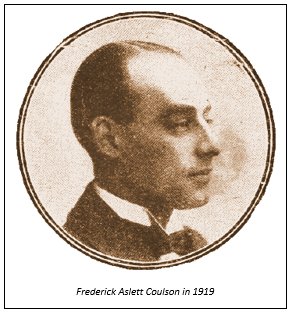 Fred Coulson was the Managing Director of the Wooler Engineering Co. from 1914 to 1917 when he decided to create his own company: the Aeroparts Manufacturing Co. Ltd., 199 Piccadilly, London with works at Parsons Green and at Empress Works, Brook Street, Holborn. His slogan at the time was "Everything Aviatish - Tube and Sheet Metal Work, Welding, Machining, Tanks, Fins, Rudders, Strut Sockets, Cowls, Eye Bolts, etc. etc.” His business grew rapidly and on the 3rd of April 1918 he incorporated a new company called Flightcraft Ltd. to get new funding for investing in new machinery as well as new premises at Kings Cross London. Directors at the time were F. A. Coulson, C. J. Axten, W. G. Fearn and J. S. Lockwood but, as the war reached an end, Coulson was forced to quickly replan his activities as the demand for aeroplanes dropped. It is assumed at this time he got back in touch with his old friend Stan who had returned from his duties at RNAS.
Fred Coulson was the Managing Director of the Wooler Engineering Co. from 1914 to 1917 when he decided to create his own company: the Aeroparts Manufacturing Co. Ltd., 199 Piccadilly, London with works at Parsons Green and at Empress Works, Brook Street, Holborn. His slogan at the time was "Everything Aviatish - Tube and Sheet Metal Work, Welding, Machining, Tanks, Fins, Rudders, Strut Sockets, Cowls, Eye Bolts, etc. etc.” His business grew rapidly and on the 3rd of April 1918 he incorporated a new company called Flightcraft Ltd. to get new funding for investing in new machinery as well as new premises at Kings Cross London. Directors at the time were F. A. Coulson, C. J. Axten, W. G. Fearn and J. S. Lockwood but, as the war reached an end, Coulson was forced to quickly replan his activities as the demand for aeroplanes dropped. It is assumed at this time he got back in touch with his old friend Stan who had returned from his duties at RNAS.
Stanley Young designed parts of the bike while Frederick Aslett Coulson produced it and marketed it under his own name as part of Flightcraft Ltd.
The first design was presented in The Motor Cycle on January 9th, 1919: “a medium weight machine of medium horse-power, and one capable of going anywhere. […] The engine fitted is a 2¾hp Blackburne, 71x78 mm 341cc […] The frame will be constructed of 1¼in light gauge tubes, combined belt and chain transmission will be fitted, while the gear box will be a two-speed Jardine. So far, as suspension is concerned, the rear portion of the machine will be provided with leaf springing, while the front of the machine is suspended on Druid Mark II forks. [..] it is expected that between 750 and 1,000 machines will be made during 1919. Already, half this number is booked up. [..] the price is expected to be around 60 guineas complete.”
The new machine, with its “distinctly racy appearance”, was initially expected to have a strong appeal to flying officers and soon became known as the Coulson B where B stands for Blackburne. Pictures of the first prototype were released in the February 20th 1919 edition of The Motor Cycle. The engine was updated to the 71mm X 88 mm Single-cylinder Blackburne of 348cc while specifications included the latest type of Brown and Barlow pilot jet carburettor, M-L magneto, a streamline silencer but also a novel stand fitted just behind the bottom bracket on which the countershaft Albion two-speed gear box was suspended. All that with a total weight of 150-160 lb.
[High resolution pictures of this prototype can be found in the Stilltime collection:
https://www.stilltimecollection.co.uk/search/coulson?qv=46d19f4c-9ee1-4c7d-a45f-347fd18a4b53
https://www.stilltimecollection.co.uk/search/coulson?qv=c37fe78a-bf5d-4b03-ba0b-b125e986bd09 ]
By April 1919 the 2¾ was reported as ready for delivery while a 3½hp Blackburne prototype was being road tested by journalists: “The particular model tested was absolutely in the rough, and quite devoid of such requirements as first class finish and enamelling, but it sufficed to give us an excellent impression of both the springing and the Blackburne engine […] It was not long before we came to the conclusion that our next mount should have a spring frame and single lever [Capac] carburetter.” – The Motor Cycle, April 24th, 1919 page 423.
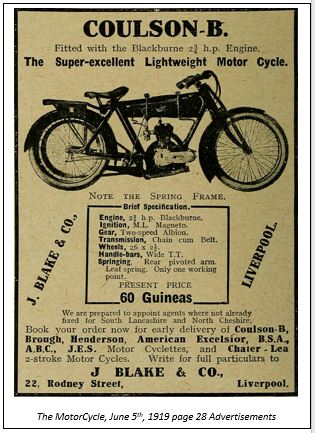 Competitions soon followed to advertise the 2¾hp model in the hands of a variety of riders:
Competitions soon followed to advertise the 2¾hp model in the hands of a variety of riders:
- D. W. Bonham-Carter
- G. A. Reed
- F. G. Rideout
- S. Parker
- S. W. Phillpott
- W.E. Wasling
- W. Ford
- and even F. A. Coulson himself
Their first agent, J. Blake and Co., of Liverpool and Manchester started accepting orders from May 1919 offering the lightweight Coulson-B for £60 guineas but by August machines were in stock at other agents and, as it happened in those post war days, prices kept on rising reaching 85 guineas by October. This pushed Coulson to write a letter to the magazines of the time to explain “Everything is doubled. The reason is not difficult to trace. The war with its trail of waste has to be paid for. A slight advance in the cost of living heralds a demand by labour for higher wages. Higher wages mean higher cost of production with a further advance in cost of all commodities. This state of affairs has been developing for some time now and, commonly known as the "vicious circle”, has advanced the rate of wages to somewhere 100% beyond prewar standard. […] Lack of understanding causes confusion and is unconvincing.
A considerable amount of present confusion arises through manufacturers advertising prices when they have not yet reached production. Subsequent events will prove in many cases that these prices cannot hold good when deliveries commence. Comparison is made between these advertised prices and the advanced prices of manufacturers who are actually delivering the goods. The well-advised intending purchaser will bear these points in mind, make his selection, and place his order now before prices advance further, rather than risk disappointment through indecision.” – The MotoCycle, October 23rd, 1919, page 466.
Fred Coulson believed in his business and kept on buying its shares as well as raise £2000 in mortgages. Stan, meanwhile, kept on refining the design in preparation for the Olympia show of November 1919 where three models were presented:
The 2¾ Coulson B (Blackburne 71x88mm 350cc side-by-side valves) now came with a rear band brake to replace the previous belt rim brake and the stand was improved to keep the machine perfectly balanced so that it may be used to raise up either the front or back wheel. It was easy to operate due to a spring which would pull it up clear and a clip at the top of the crank case.
A new 4hp Coulson B sporting model (Blackburne 85x88mm 499cc side-by-side valves) with single gear, direct belt drive and adjustable pulley (later in 1920 provided with 2 speed Albion countershaft gear). The Young spring forks were used for the first time on this model and consisted of the usual girder pattern with the addition of two leaf springs connecting the rigid to the moving portions. Priced at 90 guineas, it was expected to appeal to young motorcycle enthusiasts but there were also plans to use it for sidecar work in 1920.
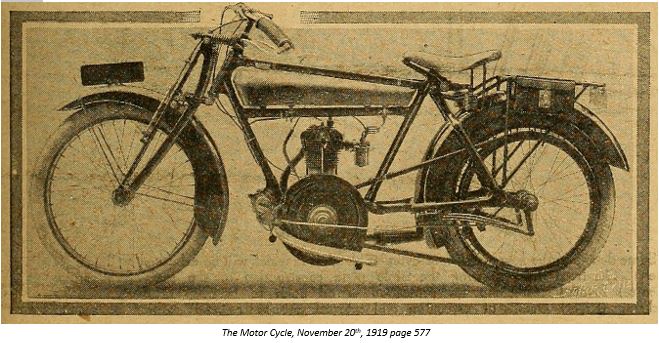
A new Coulson U 2¾hp (Union 69x78mm two-stroke 292cc) light sporting model fitted with single gear and a double silencer: a large expansion chamber below the crank case and a cone-shaped expansion chamber at the end of the exhaust pipe.
All models were fitted with the Coulson patent spring frame (Patent number GB129214 attributed to F.A. Coulson and published on January 20th 1919) and registered tank design, Lycett saddle, Dunlop belt and tyres: 26x2½ in on the Coulson B’s and 26x2¼ in on the Coulson U. E.I.C. magneto (mounted upside-down from a bracket protruding from front of frame), Capac carburettor, semi-T.T. bars, Pedley grips, and inverted levers completed the specs.
The Motor Cycling magazine took a Coulson-U for a test ride and presented a report on January 7th, 1920 (page 335). This was a brand new motorcycle which had just been assembled and never been on the road before. The little two stroke engine came to life within a few yards and run happily from King's Cross to South London. The lack of a clutch and gears didn't appear to be a problem and the bike only had to be restarted once after having been stopped in heavy traffic. The machine proved to be very handy and it was found "possible to turn in circles without stopping the engine in a main road of average width." The Union engine was capable of speeds between 5 to 30 mph without forcing it and, while it was not possible to assess steep hill climbing capabilities due to wet weather, it proved to climb a gradient of about 1 in 10 without issues.
Great marks were given to the “substantially-built” spring frame described as a "happy medium between the rigid frame machine and the type which steers badly owing to lateral play developing". Only downsides were an uncomfortable saddle and the tool kit which appeared to be somewhat inadequate.
It is unlikely the Coulson-U ever had any success but that didn’t stop Fred Coulson to use it for advertisement purposes. In early 1920 he organised a scheme to support the St. Bartholomew's Hospital which was in great financial difficulty. Motorcyclists and the trade were being asked to donate motorcycles and accessories which could be sold by public auction by the then famous comedian Mr. George Robey, C.B.E. The topic of charity was obviously a good cause but also a great opportunity for pictures of Fred and his bike to appear on the main magazines. For the occasion he chose to donate a Coulson U which sold for 65 guineas but it doesn’t seem like many other motorcycle manufacturers chose to get involved.
[High resolution pictures of this prototype can be found in the Stilltime collection:
https://www.stilltimecollection.co.uk/collection/starbike-tpt-transport-bike-nk-men
https://www.stilltimecollection.co.uk/collection/starbike-tpt-transport-bike-nk-men-broken]
By March 1920, Stanley Young had left his role as Works Manager at the F. Aslett Coulson Engineering Co. and moved to the "Y" Engineering Co. of 1. Machise Road, Kensington. This was a company financed by Mr. R.S. Whaley (owner of the Union two-stroke and the Patent Spring Fork Co.) who bought the rights to the Young fork patent (Patent number GB151827 originally attributed to S.J. Young and applied for on January 10th 1920) and was providing front forks with leaf springs. It is legitimate to assume that Fred Coulson might have adopted the then common practice of retaining rights of any invention made by his employees. Stan, therefore, would have been able to register a patent in his name only once he had left the company.
It’s not known how the departure developed but, from correspondence with Young’s sons, there doesn’t seem to have been any bad feeling between the two old friends. Young was eventually replaced at the Coulson Engineering Co. by H. Guy who had previously worked at Scott and Sunbeam and, as soon as he arrived, was quickly accredited by the press for several improvements on the 2¾hp model.
The central stand was greatly simplified to follow more modern principles; it pivoted underneath the gearbox and, when not in use, it was kept in position by means of a strong spring. A patch of leather avoided any rattle from contact with the gearbox. When in use, the front wheel was naturally kept off the ground while it was possible to remove the rear wheel letting the front wheel drop to the ground.
Some modifications were also made in the method of attaching the gear box by holding it on a slotted plate. The forward end of this plate was held by the bolt securing the front end of the chain stays, while the rear end was attached to a cross stay running across the chain stays. By this means the gear box could be easily removed or adjusted and, owing to the slot in the plate registering with the square casting on the top of the gearbox, alignment was always maintained.
The gearbox lever was also moved well forward against the tank to be quite clear of the rider's legs, a polished aluminium chain guard was added, the toolbox was improved, a magneto guard of ample dimensions was included, and the front brake was discarded in favour of two band brakes fitted one per side on the rear wheel. The operating rod of the brakes was now passing through the spindle on which one end of the band was anchored.
The most significant change was however presented in May of the same year when improvements were made to the front fork giving it a much smarter look and more flexibility.
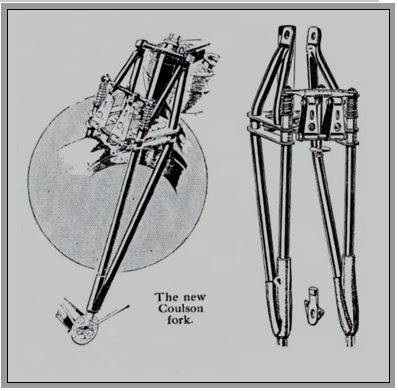 The new design somewhat resembled the Scott design because the motion was obtained by two telescopic tubes into which the fork members slide. The hollow members are bushed at either end the inner sliding pieces are connected to the wheel hub at the bottom and to two links at the top. These links then attach to two leaf springs of approximately 5 or 6 inches in length which resemble the springs on the latest "Y" patent spring fork. Coil springs were also added to damp out recoil.
The new design somewhat resembled the Scott design because the motion was obtained by two telescopic tubes into which the fork members slide. The hollow members are bushed at either end the inner sliding pieces are connected to the wheel hub at the bottom and to two links at the top. These links then attach to two leaf springs of approximately 5 or 6 inches in length which resemble the springs on the latest "Y" patent spring fork. Coil springs were also added to damp out recoil.
The 1920 model, now finished in French grey and blue, was offered with a Sturmey-Archer 2 or 3 speed countershaft gear and a choice of three types of carburettors: the Capac, the single-lever Amac and the new Silex (manufactured by Messrs. Jones and Marchant, of Weybridge). The patented spring frame and the streamlined tank were retained while clip-on handlebars were introduced.
The company kept growing despite the difficult economy of the time and, in mid-April 1920, moved its offices to 168 Regent Street, London W1. Coulson motorcycles were often present at trials throughout the year and even Mr. H. Guy had his opportunity to test his creation in several events. His main achievement in competitions was winning the special prize for the most meritorious performance in the Ballard's Cup trial on October 30th, 1920.
Multiple riders had a go on the 2¾hp and some on the 4hp model but the main rider was R.B. Clarke who tested a 3½hp prototype at the Victory Cup Trial in Birmingham and gained a Silver Medal. Success also came at the 1920 London-Edinburgh 24 hours run where Clarke won a Gold Medal and C.H. Ward a Silver.
[A high-resolution version of this picture can be found in the Stilltime collection:
https://www.stilltimecollection.co.uk/search/coulson?qv=f3ecdbd6-a8b3-44be-a50e-fc9197f1beee]
More importantly, Clark went on to win a Gold at the Scottish 6 Days trials on the only Coulson entered for the event: a 2¾hp Blackburne model. The Motor Cycle reported “This was the only 100% result achieved by any make of machine”.
Clark repeated himself at the A.C.U. Six Days Trials with another Gold but it was on September 2nd that a Coulson entered Brooklands for the first time, ridden by Capt. Maurice Charles Breese. Although he was a Physician and Surgeon by trade, in his spare time he was a sidecar enthusiast with a passion for big twins and a distinct record of significant victories. During 1920 he made thirteen records at Brooklands in the long-distance classes while in 1921 he won the Pyrenees and Bordeaux cups in the Paris-Pyrenees Six Days Trials. To complete his palmarès, he also secured the first-class award in the A.C.U. and Scottish Six Days Trials.
In September 1920, Capt. Breese rode a Coulson 2¾hp model fitted with sidecar and established four new records in Class F for motorcycles and sidecars not exceeding 350cc. He first established the 50 and 100 miles records. The former distance was completed in 1h 14m 30s at an average speed of 40.26mph, whilst the latter distance was covered at a speed of 39.69mph in 2h 31m 10s. The two hours run was covered at a speed of 39.53 mph and constituted a distance of 79 miles 122 yards, whilst in three hours a distance of 144 miles 1,344 yards was completed at an average speed of 38.25 mph; two stops were made for fuel and one for a broken chain. The fastest lap speed was 42.35 mph. Must be pointed out these records were achieved on a wet track and probably more records could have been broken if the rain did not stop the captain.
Two months later, on November 4th, Capt. Breese took six more world records at Brooklands on his Coulson:
- 2 hours average 39.62 mph
- 3 hours average 38.25 mph
- 4 hours average 38.72 mph
- 5 hours average 38.45 mph
- 6 hours average 38.35 mph
That was an astonishing result for a small company like F. Aslett Coulson Engineering Co. which had limited experience and means compared to better known marques. The total successes for the season reached 15 Gold and Silver Medals, 9 World Records and various other awards but most of all lifted the profile of the brand and significantly helped sales.
As anticipated towards the end of 1919, a sidecar was introduced in 1920 for the 4hp model and this made use of a spring axle support very similar to that employed on The Motor Cycle rear wheel. The body had two quarter-elliptical stiff springs arranged side-by-side and rigidly attached to the front ends of the chassis. The free ends of these springs were attached by means of links to solid mount points which carried the sidecar wheel spindle. This was free to move on an extension of the rear sidecar cross member, which, in the ordinary way, would be the sidecar axle. Stiff springs were adopted on purpose to ensure steady riding and the design accounted for removal of any side-play to maximise as much as possible the passenger comfort.
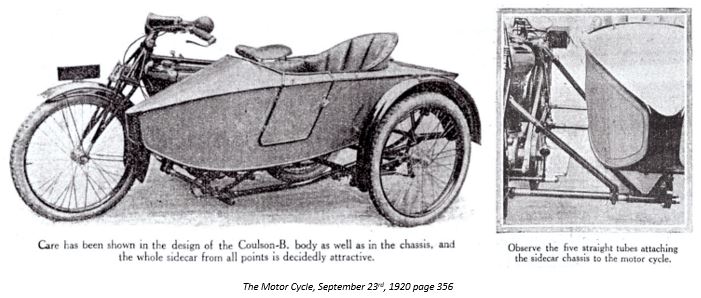
The Coulson was finally having some success and lots of dealers filled the pages of magazines with adverts of new and second-hand motorcycles. By autumn 1920 the price nearly reached £100 for the lightweight model and £110 for the 4hp. Fred Coulson however, must have felt relatively confident for the future and went on to write a letter in reply to a very pessimistic reader of The Motor Cycle magazine: “It is notoriously perilous to argue from the particular to the general, and, much as we may regret the Sopwith eclipse—which, by the way, may yet be averted—it would be a mistake to regard what has happened there as symptomatic of the state of affairs in general. Because one concern makes mistakes, it does not follow that all are going to fall into the same errors. Others have found ways of grappling with present difficulties, and things are by no means so hopeless as some of the pessimists would have us believe. The magnitude of the Sopwith defeat is in itself a factor that militates against its being repeated. Unfortunately, it has been given very widespread and none too intelligent publicity. That is where its chief mischief lies. The British motor cycle manufacturers are fighting hard, but some of us, anyhow, are making good.”
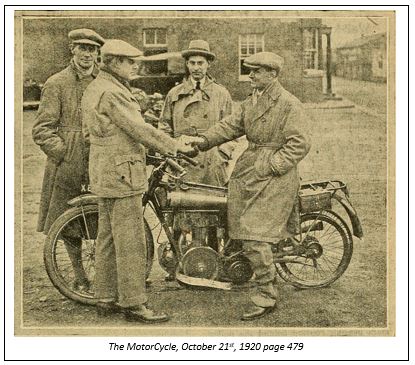 To keep the company afloat, Fred knew he had to advertise his products and often chose to rely on stunts to attract people’s attention. After the Breese records which were a great publicity stunt in advance of the Olympia Show and as the competitions season for 1920 approached the end, Fred decided to publicly test his spring frame by riding two machines from Golders Green to Hatfield (approximately 25 miles). One had no tyre on the rear rim, while the other had its tyres filled with Rubberine tyre filling. Both arrived at the destination in fine condition, without a spoke loose or a dent visible anywhere.
To keep the company afloat, Fred knew he had to advertise his products and often chose to rely on stunts to attract people’s attention. After the Breese records which were a great publicity stunt in advance of the Olympia Show and as the competitions season for 1920 approached the end, Fred decided to publicly test his spring frame by riding two machines from Golders Green to Hatfield (approximately 25 miles). One had no tyre on the rear rim, while the other had its tyres filled with Rubberine tyre filling. Both arrived at the destination in fine condition, without a spoke loose or a dent visible anywhere.
The magazines of the time reported how such tests are of no real importance without an A.C.U. observer so Rex Mundy was tasked to take a 2¾hp Coulson with sidecar from London to Edinburgh with an A.C.U. observer as passenger. The object was to complete the trip without ever stopping the engine. He succeeded in the intent and returned to Olympia just in time for the Show.
At the 1920 Olympia Show, The F. Aslett Coulson Engineering Co. dropped the two-stroke engine and presented just two models for the 1921 season: the 4hp (Blackburne engine 85x88mm of 499cc) and 2¾hp (Blackburne engine 71x88mm 349cc). These now had the following specs although different parts were fitted throughout the year:
Single-cylinder four-stroke with side valves and drip feed lubrication
Flixi carburettor
E.I.C. or C.A.V. magneto
Three-speed Sturmey-Archer gear for the 4hp and two-speed Sturmey-Archer or Albion gear for the 2¾hp (later in 1921 a 3 speed SA was introduced for the 2¾hp model)
Spring frame and Avon 26in x 2½in tyres
Two rear band brakes. each operating independently from the pedals at the front of the footboards
Nickel plated nuts and bolts throughout
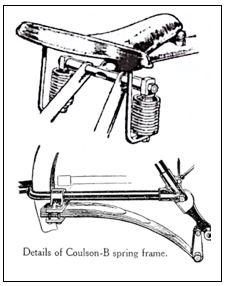
The bikes presented at the Olympia Show might not have been brand new models but still had some significant refinements: the frame was re-designed giving a saddle position nearly six inches lower than previously thus affording an excellent riding position and incidentally improving the appearance of the bike. The nose of the saddle was attached to the top tube, and the rear coil springs to a special bracket. The tank was also simplified and reinforced including a double division between the oil and petrol compartments.
The 4hp frame was also fitted with lugs cast integrally with the frame but the weight was kept low at 196lbs, and therefore was subject only to a 30s tax. In comparison, the weight of the 2¾hp model was 192lbs.
The colour scheme changed too and the 1921 models were enamelled black and panelled blue with gold lining (although this might have been introduced much earlier than the Olympia Show).
[A high-resolution version of this picture can be found in the Stilltime collection:
https://www.stilltimecollection.co.uk/search/coulson?qv=d1994411-723b-43bb-8b4a-3cd440ea3a29]
1921 started with some more successes at secondary competitions and just a small improvement on the bike’s design which moved the brake pedals from the front of the foot boards to the rear.
 The first main novelty appeared in early March when a prototype of a Coulson cyclecar was shown to the press and surprised the journalists because it was missing a proper chassis: the engine and transmission units were carried on a sub-frame bolted to the body at three points, so that, in case of a serious repair being necessary, the whole sub-frame could be lifted out bodily with the minimum amount of trouble. In line with the company standards, the body was suspended, fore and aft, on pairs of super-imposed quarter-elliptical springs and attached to long shackles.
The first main novelty appeared in early March when a prototype of a Coulson cyclecar was shown to the press and surprised the journalists because it was missing a proper chassis: the engine and transmission units were carried on a sub-frame bolted to the body at three points, so that, in case of a serious repair being necessary, the whole sub-frame could be lifted out bodily with the minimum amount of trouble. In line with the company standards, the body was suspended, fore and aft, on pairs of super-imposed quarter-elliptical springs and attached to long shackles.
Was that a deliberate attempt to make a monocoque chassis or did the designer at Coulson just copy something he might have seen while working in aviation? Hard to tell but that’s another first!
The idea was still a very early prototype and was fitted with a 777cc 6hp Blackburne V-Twin attached to the forward end of the subframe. The very first attempt at building a cyclecar didn’t have much ground clearance, had a motorcycle gearbox with a kick-starter actioned by a lever near the driver’s seat, and it still used belt transmission to the rear. These were however issues fully understood by the makers who were already planning to raise the clearance of the production model, use a proper gearbox with reverse and introduce chain transmission.
It is not known if the Coulson Cyclecar was ever completed or if the project was abandoned but the following advert appeared on The Light Car and Cyclecar edition of July 1st, 1922 which suggests some more development might have taken place:
COULSON, 8hp, 2-seater, brand new, beautifully fitted, hood, screen, Smith's clock, speedometer. DA. lighting. 3-speed. real bargain. £105
Prices of motorcycles kept on rising and the 4hp model reached £126 in April 1921 while the 2¾ was priced at £111 and £118 depending on spec; nearly double than what was announced back in 1919 and 15% higher than the price of £96 announced in February 1921 for the smaller model. The economy of the time was visibly challenging and it’s not clear what happened exactly, but the financial situation of the F. Aslett Coulson Engineering Co. started to deteriorate. A cost reduction exercise must have been started around February-April and adverts also appeared on the main papers with what looks like an attempt to justifying the reason for Coulson motorcycles being more expensive than competitors. That was quite a different message from the confident letters seen on papers during the previous years!
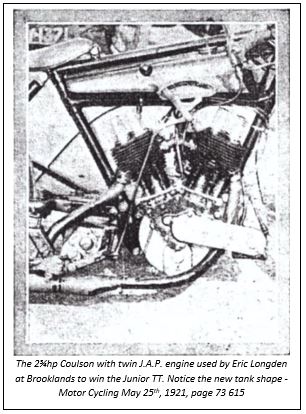
No matter what the financial situation was, development clearly never stopped; the new tank design was just an example of how the company was trying to renew itself and attract attention but, more interestingly, the same note reported “A new sports model Coulson is being placed on the market with the 2¾hp J.A.P. engine, footrests instead of footboards, and with two-speed gear at 90 gs. (£94 10s), and with three-speed gear at 6 gs. extra.”
At the same time, involvement in competitions strongly carried on around the whole country and the three golds won at the London to Edinburgh Trial are just a highlight of the Coulson successes in 1921. That year, Coulson motorcycles went back to Brooklands with three riders: V. Longden, A.F. Edwards and Eric Longden.
The latter took the new lightweight JAP model to the racetrack finished first at the second B.M.C.R.C. Members’ meeting Junior TT on May 21st, 1921. On the same day he also had a go at the Senior TT race on a 499cc (64.5 x 76 mm) Coulson Jap but failed to complete the 27 laps.
1921 was also the first time for Coulson motorcycles and spring framed motorcycles at the Isle of Man TT. Four bikes were entered for the Junior race and one for the Senior with Eric Longden set to race in both events as a privateer. Unfortunately, luck was not on his side and he had to be replaced at the last minute due to injuries received in practice. Douggie Alexander took his place in the Junior race but ran out of petrol on lap two at Creg Ny Baa and had to retire - nobody could replace Longden in the Senior TT.
The Junior Tourist Trophy Race started well for Reg Lucas who was 9th the first time around having lapped in 46m 20s but in the end, only two out of four Coulson’s managed to complete the race bringing home what should probably be considered an unexpected 15th place. Quite a result for a small company at their first TT!

Following the excursion to the island, Coulson motorcycles were seen at races on track, trials and hill climbs all over the country. The decent results achieved at these races were topped by a Gold at the Scottish Trials but, back at the factory, business was not going too well and Fred Coulson had to keep on trying to convince the public about the benefits of his product: “Given a reduction in prices, however, bringing the cost of a spring frame machine down to the level of the most ordinary rigid type - a movement that has already been initiated - the only remaining reason for using an unsprung motor cycle will disappear. Bitter experience—and common sense—overwhelmingly suggest that the motor cycle should not continue to share with the pedal cycle the distinction of giving to its rider less protection against road shocks than anything that goes on wheels.” (The Motorcycle of August 11th, 1921, page 171)
That wasn’t enough though. News of special offers of Coulson export models with 2¾ and 3½ hp Blackburne engines appeared during the month of August and it seems like a large deal failed to materialise, leaving the F. Aslett Coulson Engineering Co. and the related Flightcraft Ltd. in significant financial trouble. On August 30th, 1921, the Flightcraft Ltd. had to go into administration and just few weeks later the creditors took action and a petition for the winding-up of the Company was presented on the 19th of September 1921 by the Runbaken Magneto Company Limited. The Court sitting took place on the 18th of October 1921 and the receiver then managed to sell all assets. Some of these were purchased by Coulson riders while Mr. R. C. Empson of 15, Woodstock Street, London purchased all the spares with the goal of providing repair services for Coulson motorcycles owners. Eventually the court ordered for the Flightcraft Ltd. to be wound up on May 25th, 1922.
 Chances are that Frederick Aslett Coulson already planned for the sale of his motorcycle business therefore the Coulson brand survived and was purchased by A.W. Wall Ltd. of Tyseley, Birmingham. They moved production to Birmingham and later marketed their bikes through London Motors, 61 Holborn Viaduct.
Chances are that Frederick Aslett Coulson already planned for the sale of his motorcycle business therefore the Coulson brand survived and was purchased by A.W. Wall Ltd. of Tyseley, Birmingham. They moved production to Birmingham and later marketed their bikes through London Motors, 61 Holborn Viaduct.
No time was wasted by the new owners and prep work for the Olympia Show of that year soon got underway. Several design changes were adopted to save costs and a new 4¼hp Blackburne, a 350cc Blackburne overhead and a two-stroke 2½hp Liberty engines were introduced with the addition of Burman gearboxes as standard for all models.
The main features of the bike were retained (like front and rear springing, saddle carried on the top tube and adjustable handlebars) while several smaller novelties were introduced: internal expanding brakes on each side of the rear hub (these were reported by the press in early September therefore are likely features introduced by the previous company), wider mudguards and a new type of aluminium footboard slightly splayed in front. The stand was moved behind the gearbox while the magneto was turned downside-up and the chain cover was positioned on the outside of the flywheel. All finished with a new combination of black and blue colours.
Four models were on display at Olympia and somehow, A.W. Wall succeeded in significantly reducing prices:
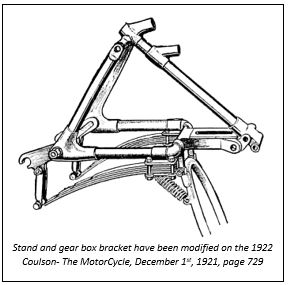
“Popular” model (2½hp Liberty 70x70mm 269cc single cylinder two-stroke) with drip feed lubrication, single lever Cox carburettor and direct driven magnetoTwo-speed Burman gearbox, clutch and kick-starter
Chain-cum-belt drive; 26x2¼ tyres with two internal expanding rear brakes
Price solo £67 10s
“Sports” model (2¾hp Blackburne 71x88mm 348cc single cylinder four-stroke side valve) with hand pump lubrication, single lever Cox carburettor and chain-driven magneto
Two-speed Burman gearbox, clutch and kick-starter (later in 1922, two and three speed versions were made available)
Chain-cum-belt drive; 26x2½ tyres with two internal expanding rear brakes
Price, two-speed solo £78
Price, three-speed solo £82 10s
“T.T.” model (2¾hp Blackburne 71x88mm 348cc single cylinder four-stroke OHV) same specs as the previous model but includes a three-speed Burman gearbox with clutch and no kick-starter
Price, solo £95
“Touring” model (4¼hp Blackburne 85x96mm 550cc single cylinder four-stroke side valve) same specs as the previous model. This could be provided as a solo or with a sidecar
Price, solo £95
Price, combination £120
Involvement in racing continued as if nothing happened and an advertising campaign started right away: the Coulson motorcycle was now compared to a Limousine to raise awareness of the springing benefits.
The new bikes also went on display at the Scottish Motor Show which opened on January 27th, 1922 and very positive comments appeared on the papers: “With an o.h.v. 2¾hp Blackburne engine in a neat spring frame, the T. T. Coulson promises possibilities of speed and comfort cleverly combined in suitable proportions. All-chain drive through a close ratio Barman gear box, less clutch and kick starter, is employed, and the handlebars, footrest position, and such details are essentially those of a sporting machine. The price is £95, which is also the figure charged for the 4¼hp side-valve Blackburne - engined touring. A Sports sidecar attached to the latter costs £25 extra.”
On April 8th, 1922, F.V. Jones started racing a Coulson 2¾hp motorcycle as a privateer at Brooklands and managed to finished third at the 350cc scratch race held at the first 1922 Brooklands Meet. His bike was fitted with a 349cc JAP OHV single (70 x 90mm).
On that day he also raced in the Private Owner’s Handicap race and, although he had a great start leading for the entire first lap, he was then overtaken by several riders and only managed to finish 6th. The following month he had better luck finishing third in the 350cc One Lap Scratch Race at the South Midland Centre A.C.U. meeting at Brooklands.
In May of the same year, chain driven Coulsons made their first appearance in the Tourist Trophy Race on the Isle of Man. These were the forerunners of an all-chain model A.W.Wall was planning to introduce for 1923. The wheelbase was shortened to adjust to the new transmission and the racing models were fitted with a separate oil tank as well as a Showell mechanical oil pump with an auxiliary foot pump. Other features of these racing bikes were Druid forks, Webb internal-expanding brakes front and rear, M-L magneto, Hutchinson 26x2½ tyres and Burman gears.
Four Coulson bikes in total were entered for the event. London Motors entered two for the 250cc Lightweight Junior TT and one for the 350cc Junior TT while Reg Lucas registered as a privateer in the 350cc Junior TT. There was no entry for the Senior race.
In line with the overall TT results, only two out of four Coulson bikes managed to finish the races securing a 9th place in the Lightweight Junior TT and an astonishing 4th place with Reg Lucas in the Junior TT.
Although Coulson motorcycles did not win, this was still the best result ever achieved by a spring framed motorcycle at the TT. London Works did not miss the opportunity and immediately started advertising the reliability features of their bikes as proven on the island.
Some even better results came from Brooklands on the 10th of June 1922 when Coulson won two races in a day.
Event 1, a two lap handicap race for motorcycles up to 350cc, saw nineteen competitors on the starting line, and among these, Le Vack was present on the machine he rode in the Isle of Man, J. V. Prestwich rode a JAP-engined side valve Coventry Eagle and F. A. Longman rode the A.J.S. entered by Harry Martin.
At the end of the first lap, F.V. Jones (Coulson 348cc JAP side valve) was leading, Watson (Douglas) and Fairweather (Coulson) were striving for second place. It’s not clear what happened to Fairweather on lap two, but Jones was not to be caught and went on to win the race at an average speed of 59.29mph.
Event 4 was instead a five-lap handicap race for lightweights and juniors. There was an excellent entry, but as the limit man had 4 min. 20 sec. start of the scratch man, he, and others near him, had finished their first lap before the scratch man had started. Consequently, the public became thoroughly confused and doubted the results. Nevertheless, C.M. Fairweather happily crossed the line first on his Coulson (249cc Blackburne OHV) at an average speed of 61.17mph.
[High resolution pictures of these racing Coulson bikes can be found in the Stilltime collection:
https://www.stilltimecollection.co.uk/search/coulson?qv=efc3e06b-3f86-4775-9079-71a18748a751
https://www.stilltimecollection.co.uk/search/coulson?qv=87b42ba7-3879-4b77-bd36-c538676c88ac]
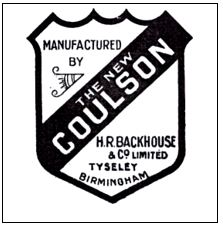 Aside from decent results in competitions, sales of Coulson motorcycles must not have been that substantial and A.W. Wall decided to pull the plug towards the end of 1922. No bike was presented at Olympia and eventually the rights for the Coulson design were sold to H. R. Backhouse of Tyseley, Birmingham. They attempted to revamp sales by rebranding the marque to New Coulson, introducing more models than ever before and also lowering prices even further.
Aside from decent results in competitions, sales of Coulson motorcycles must not have been that substantial and A.W. Wall decided to pull the plug towards the end of 1922. No bike was presented at Olympia and eventually the rights for the Coulson design were sold to H. R. Backhouse of Tyseley, Birmingham. They attempted to revamp sales by rebranding the marque to New Coulson, introducing more models than ever before and also lowering prices even further.
The evolved NEW COULSON was promoted as “an improvement even upon the famous COULSON of the past - a real sporty machine that looks speedy and IS speedy - a mount upon which you can go "all out'' with absolute confidence, knowing that it is "built for speed and endurance” and will never let you down.
There is a character and attractiveness about the new COULSON that irresistibly appeals to the man who appreciates individuality - the handsome streamline tank and silencer, the graceful lines of the complete machine, please the eye and give a feeling of pride in its possession.”
The “speedy line” resulted in the spring frame being replaced on most models by a more common rigid frame but, as noticed at the TT, all-chain drive was introduced and as a result the frame was shortened to adapt it to the new transmission. The bearing surfaces for the links of the rear spring frame were much increased in proportions, and each pivot pin was provided with a lubricator. Surprisingly, on the 1923 catalogue, the cost of a spring frame was the same as a rigid frame.
The process of simplifying and standardising the Coulson design inevitably removed the central stand (replaced by a more common type carried on the rear fork extension) and the footboards were replaced by adjustable footrests. Probably, a real novelty was the provision for the fitting of a Magdyno without alteration to the normal magneto bracket.
Specifications of the seven New Coulson models were listed on the 1923 catalogue as follows:
Model J (2½hp Liberty 70x70mm 269cc single cylinder two-stroke)
Two-speed Burman gearbox, clutch and kick-starter
Rigid frame, Druid forks and direct-acting brake operating in the rear belt rim
Price, solo £38 (£42 by July 1923)
Model S (2¾hp Blackburne 71x88mm 348cc single cylinder four-stroke side valve) with Best & Lloyd automatic oil pump feed, Amac carburettor and M.L. magneto
Spring frame, Druid fork and adjustable footrests
Three-speed Burman gearbox with clutch, kick-starter and shock absorber
Chain-cum-belt drive; 26x2½ tyres with extra large internal expanding brakes front and rear
Price, solo £57 10s
Model R same as model S with rigid frame and all chain drive and mechanical oil pump
Price, solo £57 10s
Price, combination £72 10s
Model B (2¾hp Bradshaw 68x96mm 348cc single cylinder oil cooled OHV) same specs as Model R and Fellows E.A.1 magneto
Price, solo £57 10s
Model O (2¾hp Blackburne 71x88mm 348cc single cylinder four-stroke OHV) same specs as Model R and three-speed Burman close ratio gearbox
Price, solo £65
Model R4 (4¼hp Blackburne 85x96mm 550cc single cylinder four-stroke side valve) with mechanical oil pump and large capacity tank
Rigid frame, heavyweight Druid forks and adjustable footrests
Three-speed Burman gearbox all-chain shock absorber
All chain drive; 26x3 tyres with extra-large internal expanding brakes front and rear
Price, solo £68
Model C4 same as model R4 with Coupette Sidecar and complete with all accessories including Lamps, Horn, Hood Screen, Leg-shields and License holder
Price, combination £95
The adjustable handlebars and saddle fittings were retained to maintain the very low riding position. The frame was enamelled black and the tank was described as blue with gold lining but pictures on the catalogue showed what could be a tank with white panels for the Bradshaw model and a slightly darker colour for the R model.
Privateers kept on racing Coulson motorcycle throughout 1923 but the charming of the spring frame faded out of fashion and the brand did not survive past 1924.
The following is just a partial account of races at Brooklands where Coulson motorcycles were entered (courtesy of Roger Bird, historian at the Brooklands Museum Library):
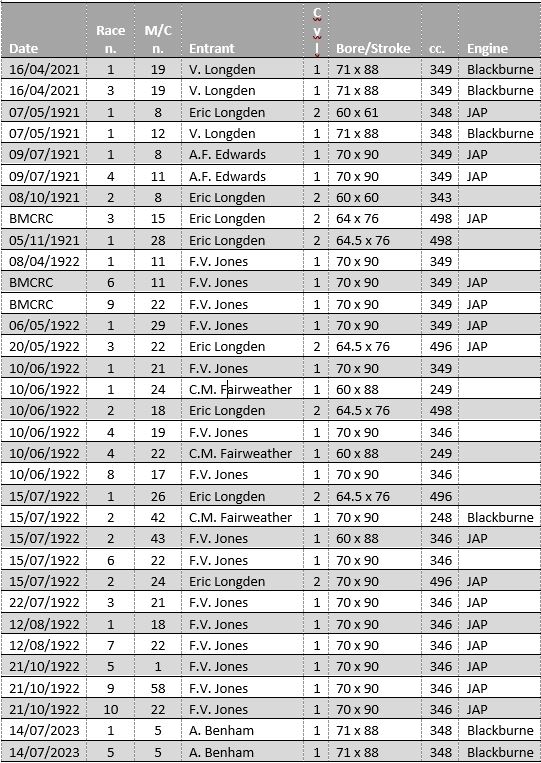
Frederick Aslett Coulson had some legal trouble getting through the closure of his motorcycle business because creditors raised a petition on February 23rd, 1922, for his own bankruptcy. The case went on for some time and on October 18th, 1922, the Court ordered “Bankrupt's discharge suspended for two years. Bankrupt discharged as from Oct. 18, 1924.” Before the end of the two-year period, a trustee was nominated who likely managed some assets which could not be sold. It is not known what these might be but, by 1938, the company was still generating 5s 3d of dividends!
Fred however abandoned the motorcycle and aviation business in 1921 reinventing himself as a “Wireless Factor and General Agent” and creating a company simply called F. A. Coulson -company with offices in 273 Archway Road, Highgate, London. In 1931, probably due to the financial crashes of the time, he went bankrupt once again but somehow, he got back on his feet and kept on trading as an Electrical & Radio agent until around WW2. He died in mid-1953.
Stanley John Young didn’t stay in the country for long and got involved in the advertising business following in his father’s footsteps and promoting motoring pictures. He travelled a lot around the world and was living in Barcelona when the Spanish revolution started. He managed to escape to Paris with all his family and from there he moved to Africa a year later. He only returned to England (Salisbury) when he decided it was time to retire. In May 1961, a doctor misdiagnosed a heart attack and he passed away.
As far as the writer is aware, only four and a half machines have survived: one 1919 and one 1921 500cc in England, one 1920 500cc in Scotland and one 1921 350cc residing in Italy. Half a Coulson 500cc is being brought back to life in Scotland.
Just one New Coulson remains and is preserved at the National Motorcycle Museum in Solihull.
For amendments and additions to this story as well as information about the people who lived it, please contact facoulsoneng@gmail.com

